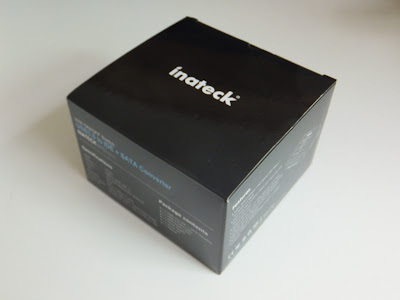A few friends of mine needed data recovery from old broken computers they had. Most of them had a tower form factor PC with old IDE drives or more recent ones with SATA port.
For those no issue: Having old working PCs around ... Only needed to drop the HDD in the PC and voilà.
But recently, two friends had Laptops IDE HDDs and i had no way to save their data!
For those no issue: Having old working PCs around ... Only needed to drop the HDD in the PC and voilà.
But recently, two friends had Laptops IDE HDDs and i had no way to save their data!
Inateck USB3.0 to IDE + SATA converter
A kind of a Savior
A kind of a Savior
To be able to read these old laptop IDE HDDs i needed something new.
Here is what i needed:
The ability to
After some search I came across the Inateck USB3.0 to IDE + SATA converter [I am not affiliated in any way with Amazon or Inateck, this is just a personal experience.]
- access SATA drives (to use 3.5" HDD on a laptop)
- access old 3.5" IDE drives
- access old 2.5" IDE drives (what I specifically needed this time)
- an external PSU, that's not the poor 5V 500mA that will power a 3.5" IDEdrive
- a power switch button to be able to "hot swap" the converter and "cold swap" the drives
After some search I came across the Inateck USB3.0 to IDE + SATA converter [I am not affiliated in any way with Amazon or Inateck, this is just a personal experience.]
Unboxing
What's inside the box (for real?)
What's inside the box (for real?)
Advertised content is contractual with the description of the product:
There is:
- The converter itself (model UA2001)
- USB3.0 cable
- Molex power cable
- Power Supply (12V, 2A rated, with a 20AWGX2C; isn't 20AWG rated for 1.5A max?)
- Driver CD, useless on linux
- Instructions manual, explaining how to use the backup software
Converter sepcs:
Notes: The converter is made of quite thick and solid black plastic (1mm thick on the edges), it is not "pretty" but it looks tough and reliable (ok, the last thing that i thought was tough -a Nitecore flashlight- failed me).
The molex adapter is made of small gauge wires (20AWG) so it shouldn't be able to power a Sony Optiarc AD-5260S (5V/1.5A,12V/2.5A!)
- SATA port
- 44 pins laptop IDE port
- 40 pins 3.5" IDE port On the back side:
- On/Off switch
- 12V 2A input port
- USB3.0 port
- 12V+5V output port (for the MOLEX adapter) On the top:
- Backup button
- power LED
Notes: The converter is made of quite thick and solid black plastic (1mm thick on the edges), it is not "pretty" but it looks tough and reliable (ok, the last thing that i thought was tough -a Nitecore flashlight- failed me).
The molex adapter is made of small gauge wires (20AWG) so it shouldn't be able to power a Sony Optiarc AD-5260S (5V/1.5A,12V/2.5A!)
Does it actually work?
Yes it does its job
Yes it does its job
Due to wide compatibility, either the drive or the converter is hanging and not lying on the table. This is not for daily usage in a crowded place but more as an occasional help.
It even works with more than one devices plugged: the datasheet says "Operates with one IDE and one SATA HDD Simultaneously"
Actually lsblk recognises correctly 3 disks when the 2 IDE ports are populated and the SATA too (all with HDDs contrary to the picture above). (though i didn't tried to read/write massive amount of data simultaneously)
sda: internal HDD
sdb: SATA HDD
sdc: 2.5" IDE HDD
sdd: 3.5" IDE HD
So it works on Linux computers, but can we use it as USB OTG reader for an Android device?
OTG mode
What about android?
What about android?
Let's say you don't have a PC (as if it died, but the HDD and your data are still safe but unreachable).
This adapter works flawlessly in OTG mode using a simple OTG cable used to read USB flash-drives on Android devices.
There's nothing to fear about, the power supply of the HDD is done by the adapter PSU so the Android device won't drain itself trying to power it.
This adapter works flawlessly in OTG mode using a simple OTG cable used to read USB flash-drives on Android devices.
There's nothing to fear about, the power supply of the HDD is done by the adapter PSU so the Android device won't drain itself trying to power it.
Conclusion
Global feelings
Global feelings
The overall quality of the product is quite good considering the price.
I think it is a great product for the usage i have i.e. data recovery once in a while. But it is definitely not for professional or intense usage like 7hrs/day&5days/week. (less compatible and more specific devices would do the job better, like one for SATA, one for 40pins IDE and one for 44pins IDE)
It has great compatibility both with devices and hosts: it could read anything i tried (SATA/IDE HDDs, IDE and SATA CD/DVD drives) on any platform (Windows, Linux and Android [sadly CD/DVDs couldn't be read on my smartphone])








